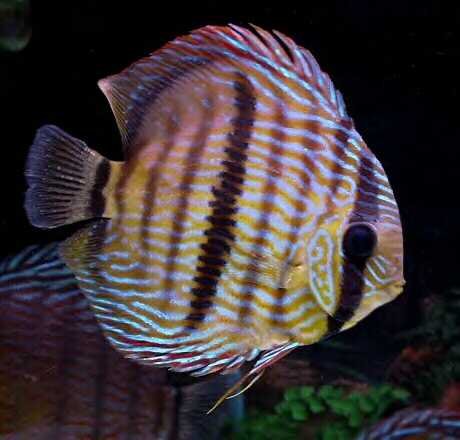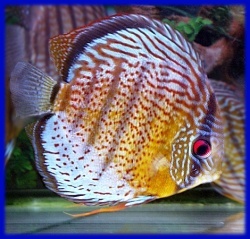
Wildcaught Discus
Aquarium Plants and information for the Discus aquarium.

 |
DISCUS |
| Discus Information - The
origins of Discus. The King of Aquarium fishes ; this
graceful cichlid hails from the Amazon river system, one
of the largest and most stable biotopes on our planet. It
was first introduced in the early 1930's , 60 years on,
it's still considered one of the more demanding and
expensive fish to be kept. These fishes are found in various parts of the vast river system. There are basically 3 types of water composition along the Amazon river, the loam-yellow or "white" upper Amazon, the "black water" (near Rio Negro) in the central region and the green-yellow or "clear water" lower region. The various types of water host different colour variety of discus, but generally the water has very low mineral content and are termed as "soft" water. The pH value are more towards the acidic side, especially near the "black water" region where many of today's colourful "Grand Daddies" of discus are found. The round bodies of the fish are linked to its habit of liking to hide in heavily vegetated or exposed tree roots areas, thus allowing it to glid through the plants with ease. The first acknowledged discus species are the Symphysodon aequifasciata (the common discus) and S. discus (Heckel or red discus), each with its own subspecies. The S. aequifasciata (has 9 distinct dark bands on the body) has 3 recognised subspecies : which are firstly the S. aequifasciata aequifasciata Pellegrin (known as the Green discus from the central Amazon) , secondly the S. aequifasciata axelrodi Shultz (the Brown discus from the lower Amazon) and lastly the S. aequifasciata haraldi Shultz (the Blue discus from the upper Amazon). The S. discus (possess 3 distinct dark bands on the body) has 2 recognised subspecies : they are S. discus discus (known as the Heckel or red discus from Rio Negro and north of Amazon) and S. discus willischwartzi Burgess (the pineapple discus from Rio Abacaxis, south of Amazon). The hundreds (or maybe thousands) of colour varieties that one can find in today's aquarium shops are probably originated by hybridizing the natural subspecies and species. The many varieties you find today are the result of careful breeding and selection process which resulted the various strains. The great popular demand for these varieties has resulted more and more people breeding and producing new strains, thus making discus the Single most "hybridised" aquarium fish in the history of fishkeeping. Source : Dr. Axelrod's Atlas of Freshwater Aquarium Fishes (3rd ed) |
|
|